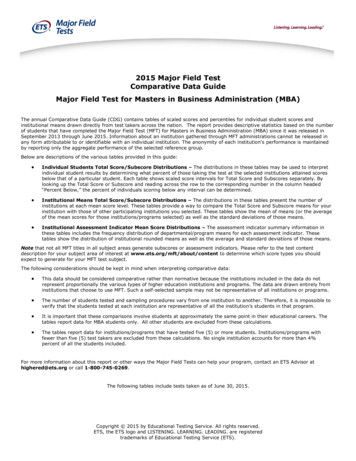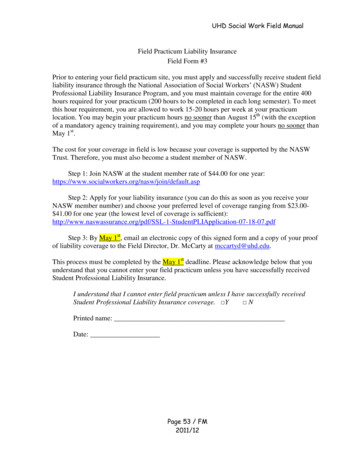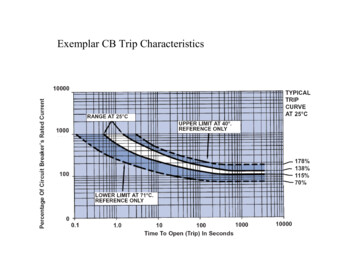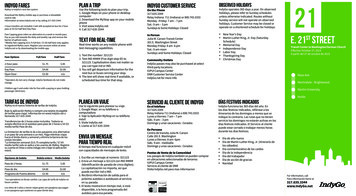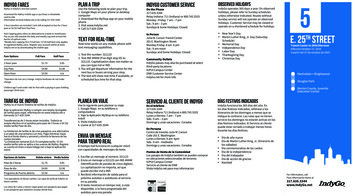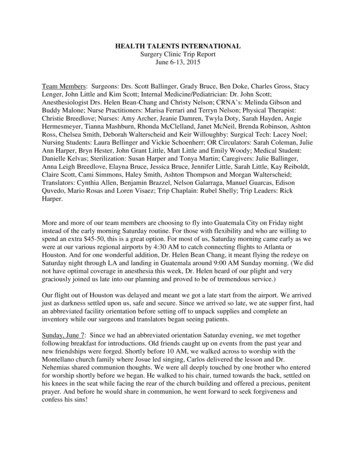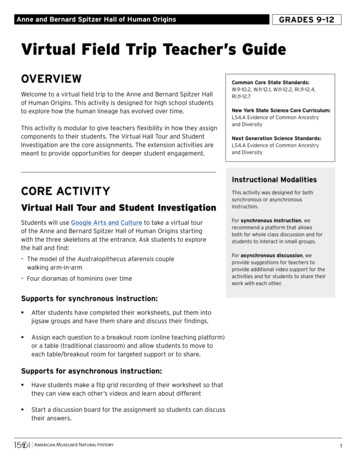
Transcription
Anne and Bernard Spitzer Hall of Human OriginsGRADES 9–12Virtual Field Trip Teacher’s GuideOVERVIEWWelcome to a virtual field trip to the Anne and Bernard Spitzer Hallof Human Origins. This activity is designed for high school studentsto explore how the human lineage has evolved over time.This activity is modular to give teachers flexibility in how they assigncomponents to their students. The Virtual Hall Tour and StudentInvestigation are the core assignments. The extension activities aremeant to provide opportunities for deeper student engagement.Common Core State Standards:W.9-10.2, W.11-12.1, W.11-12.2, RI.11-12.4,RI.11-12.7New York State Science Core Curriculum:LS4.A Evidence of Common Ancestryand DiversityNext Generation Science Standards:LS4.A Evidence of Common Ancestryand DiversityInstructional ModalitiesCORE ACTIVITYVirtual Hall Tour and Student InvestigationStudents will use Google Arts and Culture to take a virtual tourof the Anne and Bernard Spitzer Hall of Human Origins startingwith the three skeletons at the entrance. Ask students to explorethe hall and find:– The model of the Australopithecus afarensis couplewalking arm-in-arm– Four dioramas of hominins over timeThis activity was designed for bothsynchronous or asynchronousinstruction.For synchronous instruction, werecommend a platform that allowsboth for whole class discussion and forstudents to interact in small groups.For asynchronous discussion, weprovide suggestions for teachers toprovide additional video support for theactivities and for students to share theirwork with each other.Supports for synchronous instruction: After students have completed their worksheets, put them intojigsaw groups and have them share and discuss their findings. Assign each question to a breakout room (online teaching platform)or a table (traditional classroom) and allow students to move toeach table/breakout room for targeted support or to share.Supports for asynchronous instruction: Have students make a flip grid recording of their worksheet so thatthey can view each other’s videos and learn about different Start a discussion board for the assignment so students can discusstheir answers.1
Anne and Bernard Spitzer Hall of Human OriginsGRADES 9–12EXTENSION ACTIVITIESTo deepen student engagement with this content, you may choose to add one ormore of the following extension activities:Virtual Lab ExperienceTo deepen student engagement with this content, you may choose to add aVirtual Lab Experience to explore Genetics or Human Evolution. These virtual labsinclude video tutorials and hands-on activities.Reading AssignmentStudents can prepare for their virtual visit by reading a non-fiction text about humanevolution titled “Evolution: How It Works.” This reading can help introduce the topic orserve as a content refresher to help frame their investigation.Supports for synchronous instruction: Student Reading As they read, have students annotate the text and write notes in the margin.For example, they could underline key passages, paraphrase important information,or write down questions that they have. They may also use this space for drawingsor diagrams of what they are reading about. After reading, ask students to: (1) Define variation and give an example. How doesvariation relate to evolution? (2) Identify two types of evidence that supportevolution. During discussion, remind students to use evidence from the text toexplain their thinking, and to use specific examples.Answers may vary, but should include: (1) Wariation is the diversity of traits wesee in organisms such as different eye color. (2) Types of evidence for evolutionmentioned in the article: Fossil record, DNA evidence, direct observation, althoughthis is not covered in detail. Then, have students create a venn diagram (such as a multi-columned T-chart)to compare and contrast fossil evidence to genetic evidence.Supports for synchronous instruction: Student Reading Record a video of yourself reading “Evolution: How It Works.” This will allowstudents to pause or relisten to the reading so that they have time to take notes,paraphrase important information, or write down questions that they have.2
Anne and Bernard Spitzer Hall of Human OriginsGRADES 9–12Writing TaskThis informational writing task asks students to draw on the reading and observationsrecorded during the virtual field trip, to synthesize what they learned about humanevolution. The writing task should only be assigned as culminating work, if studentshave also completed the reading and answered the questions from the studentinvestigation.Student Writing TaskBased on your reading and your exploration of the Anne and BernardSpitzer Hall of Human Origins to synthesize in writing what you learnedabout human evolution. Be sure to:y define evolution and variationy Using the reading, explain the physical and behavior changes that hasoccurred in the human lineage over time.y describe the evidence that sports how we know these changes haveoccurredy include a chart that highlights the major differences between humans andthe other species.Support your discussion with evidence from the reading and the SpitzerHall of Human Origins.Supports for synchronous instruction: Writing Task Re-read “Evolution: How It Works” with students. Ask what they saw in the hall thathelps them understand human evolution. Allow time for students to read their essay drafts to a peer and receive feedback.Supports for synchronous instruction: Student Reading Ask students to re-watch the video of the teacher reading of “Evolution: How ItWorks.” While they view it, ask them to write down how what they saw in the hallhelps them understand how plate tectonics explains specific rock formations. Use Padlet so that students can share work with one another.3
GRADES 9–12Hall of Human OriginsANSWER KEYStudent Worksheet: Hall of Human Origins Virtual Tour1. Locate the three skeletons at the entrance to the hall (Page 5). On the far left is achimpanzee (Pan troglodytes), in the center is a modern human (Homo sapiens), and on the farright is an extinct species called Neanderthals (Homo neanderthalensis). The human and theNeanderthal share many features related to bipedalism (walking on two legs).a. Compare the human and the chimpanzee. What similarities do you see? What differences do you see?Similarities:Students can make any similarties such asboth have four limbsDifferences:The chimpanzee has a larger brow than thehumanThe chimpanzee has opposable thumbs andhumans do notThe chimpanzee is bent over on all 4 limbs.The human is bipedal and uprightb. Compare the human and the Neanderthal. What similarities do you see? What differences do you see?Similarities:Differences:Examples include:Examples include:Both are bipedal and standing uprightThe human is taller than the NeanderthalBoth have a prominant nasal boneThe Neanderthal has a broader rib cage andbroader hip bones than humansThe Neanderthal’s legs are more bent at theknee than humans1
GRADES 9–12Hall of Human OriginsANSWER KEYStudent Worksheet: Hall of Human Origins Virtual Tour2. Based on your observations, which species do you think is more closely related to modernhumans (Homo sapiens)? Explain your answer.Neanderthals are more closely related to humans because they are bipedal, walk upright, and have a similarskull structure to humans.3. Observe the Family Tree (Page 6) . You should see several skulls organized from oldest(bottom) to most recent (top). This type of tree allows scientists to demonstrate evolutionaryrelationships among species. Displayed here are several species of early humans (also calledhominins). On the top right is the skull of a modern human (Homo sapiens). As you look fromthe oldest species (bottom) to the most recent species (top) what changes do you notice in theshape of the skull?As I look from the oldest to the most recent species, the cheekbones get more narrow, the brow gets smaller,the top of the skull gets smaller and more rounded, and the mouth and chin protrude out less.4. O bserve the diorama of Australopithecus afarensis. (Page 7) You should see a male and afemale walking arm in arm. This is a hominin species that existed between 4 million and 3million years ago. The most famous fossil of this species is named Lucy. In what ways are theysimilar to our own species? In what ways do they differ from our species?Similarities:Differences:Examples include:Examples include:bipedal and standing uprightAustralopithecus is shorter, has more bodyhair, and has a chin that protrudes out morethan humans2
Hall of Human OriginsGRADES 9–12ANSWER KEYStudent Worksheet: Hall of Human Origins Virtual Tour5. Observe the diorama of Homo erectus/ ergaster (Page 8). You should see two individuals, amale and female, standing over an antelope carcass. This species existed between 1.9 millionand 110 thousand years ago.a. Describe the scene.Descriptions are not limited to, but can include: description of the terrain, what can be seen in thebackground, the number of individuals, how their bodies are positioned, and if they are holding anything.b. I n what ways are they more similar to modern humans (Homo sapiens) than to Lucy’s species(Australopithecus afarensis)?The facial feature are more human like: homo erectus appear taller than Lucy like humans. Their mouth andchin do not stick out as far and teeth are visible.6. Observe the diorama of the neanderthals (Homo neanderthalensis) (Page 9). You should seethree individuals draped in fur, a young male, a young female, and an older female. This speciescoexisted with modern humans (Homo sapiens) and lived between 400,000 thousand and40,000 years ago.a. Describe the scene.Descriptions are not limited to, but can include: description of the terrain, what can be seen in thebackground, the number of individuals, how their bodies are positioned, and if they are holding anythingb. H ow does the environment differ from that of Homo erectus/ ergaster?The environment of homo erecturs appears to be more dry because of the brown grass, and ground coveredwith a mix of rocks and dirt. The Neanderthal environment has more trees and grass and a water source inthe background.c. In what ways do the Neanderthals differ physically and behaviorally from Homo erectus/ ergaster andAustralopithecus afarensis?Neanderthals look taller, and have longer hair on their heads. Neanderthals may be more social since theywere in a group of 3. They might use more tools in unique ways since they are wearing and sitting on animalpelts.3
Hall of Human OriginsGRADES 9–12ANSWER KEYStudent Worksheet: Hall of Human Origins Virtual Tour7. Observe the diorama of the early European Homo sapiens. (Page 10) You should see a malein fur clothing carrying a bundle of sticks on his shoulders. Our species has existed fromapproximately 300,000 years ago to the present.a. Describe the scene.Descriptions are not limited to, but can include: description of the terrain, what can be seen in thebackground, the number of individuals, how their bodies are positioned, and if they are holding anything.b. H ow does this scene differ from what you saw with the Neanderthals (Homo neanderthalensis) ?The Neanderthal scene had a cliff as well as grass and trees in the background. The Neanderthals werewearing animal fur, but their full bodies were not covered. European Homo sapiens are in an area with snowand a water source, but there is no grass or trees. They are also have on shoes and are covered from headto toe in fur.8. Based on your observations, what are some ways that the human lineage (hominins) havechanged over time?Answers may include: Over time the human lineage has lived in different environments and terrains.Homo erectus/ ergaster lived in more dry conditions and early homo sapies lived in more cold and wetenvironments. We changed from walking on all fours to being bipedal and walking upright. Our brows havebecome smaller, and chin and mouth point out less.4
coexisted with modern humans (Homo sapiens) and lived between 400,000 thousand and 40,000 years ago. a. Describe the scene. Descriptions are not limited to, but can include: description of the terrain, what can be seen in the background, the number of individuals, how their b
